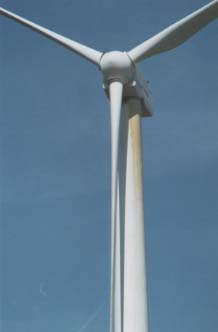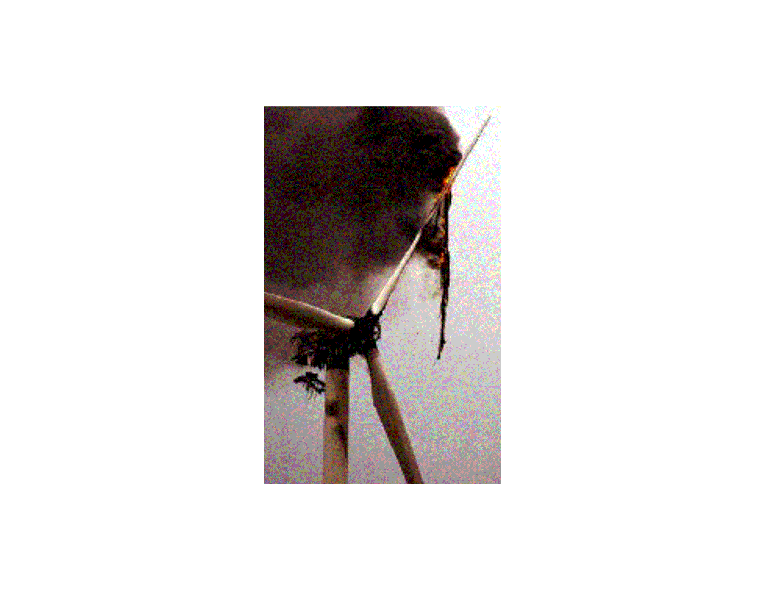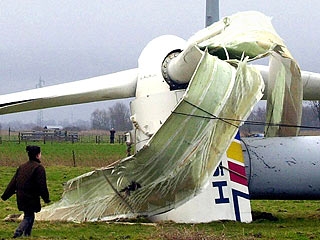| Windfarms - an ecological and human disaster in the making |
(1170) |
| A CASE IN POINT: THE VALENCIAN WINDPOWER PLAN |
| LANDSCAPE, TOURISM, RECREATION ACTIVITIES, PROPERTY VALUES, SOIL EROSION, FOREST FIRES, WATER QUALITY, FRAGMENTATION OF WILDLIFE HABITAT, BIRD SURVIVAL, INSPIRATION, RELAXATION, STRESS, HEALTH, QUALITY OF LIFE. |
The Valencian windpower plan ("Plan Eólico") was approved July 26th, 2001. It calls for the implantation of 2700 wind turbines in the Comunidad Valenciana, many of them in the mountains of the Costa Blanca.
After two years of negotiations behind closed doors, the pieces of the subsidized pie have been allocated. Soon the bulldozers will start destroying the ultimate asset of this region: its unspoiled interior. See the narrow valleys, smell the orange blossom, marvel at the olive groves: they will never be the same. Neither will the craggy mountains, warm shades of amber in the winter sun. All of this will go, marred by industrial structures. The almond trees will bloom under ugly pylons, and we´ll view the cherry blossoms against a backdrop of rotors and power lines.
Quarries will be opened in the mountain flanks, and one million tons of concrete will be poured onto the crests, moulded into as many 400 ton anchors as there are turbines. Standing 100 meters tall, the steel-and-plastic mills will be visible many miles around, spoiling the horizons as far as the eye can see.
Pristine landscapes will be hard to find for the ritual Sunday drive, or a serene weekend in the mountains. Rural tourism will suffer. Mountain walkers, hunters, delta-plane enthusiasts, fishermen, bird watchers, nature lovers of all walks of life will cry over their lost paradise. One way or another, the quality of life of the whole population will take a setback.
Environmental damage will be important. The destruction of eagles, falcons, birds and bats of all species will start with the first flick of the blades, which travel at up to 292 Kmh at the tip*. As time passes, rainstorms will carve the land around the concrete blocks, stripping the topsoil no longer protected by vegetation. The circulation of cranes and other maintenance vehicles throughout the life of the "farm" will make things worse. A report by AGADEN on the Tarifa windfarms is eloquent when it comes to erosion. I enclose it below.
* speed of the blade tips: see Birds and windfarms – Bird and Bat Behavior at windfarm sites.
Space-consuming windfarms, fences and access roads will further divide wildlife habitat, as if it weren´t fragmented enough by existing man-made constructions, roads, walls and enclosures.
The Plan Eólico itself mentions some impacts we would never have suspected, such as the contamination of ground water by "accidental spills" of motor oil and cleaning liquids. Indeed, it is a fact that each turbine, depending on the model, stores up to 400 litres of oil in the nacelle to lubricate its moving parts: this liquid is known to drip from the tip of the blades when idle, or be projected afar when they rotate. Here is a picture of an oil leak alongside a tower:

Picture above: from the ivestigation of Iberica 2000 into the Navarre windfarm scandal.
"Accidental spill" is also a euphemism for illegal dumping of oil changes and other liquids. Some of these, like those that are used to clean the huge blades when dirt and dead insects hamper their aerodynamics, cannot but end up in the ground.
Another hazard is fire, of particular concern in the dry Province of Alicante, which fears desertification. An article in the Tri-Valley Herald of California reports 36 turbine-related fires in one year:
FIRES CALIFORNIA
In Germany, they already had 255 accidents, including many fires:
TURBINE ON FIRE
ANOTHER TURBINE ON FIRE
MORE TURBINES ON FIRE SCROLL DOWN
Shorts in the nacelles, which house the generators, cause some of the fires. Others are caused by lightning.

Photo above: turbine set on fire by lightning - courtesy of www.rommersheim-gegenwind.de
For the neighbours, a wind farm can make life a living hell. Not only do they lose their views, the amenity of their surroundings, but they have to deal every day with the noise, the shadow flicker, and a property that no-one wants to buy - see the letter written by a distressed Swedish lady: LETTER
Many documents relate to windfarm noise pollution: click NOISE
I travelled to Scotland to investigate this green electricity, which bird lovers call "red energy" because of the spilled blood. There, I have seen first-hand how once peaceful communities have become divided and hateful. On one side are the politicians and a handful of landowners, who stand to make money with the project; on the other are those people who realise the true extent of the coming disaster.
Greed runs amuck when rents in the thousands of pounds are offered to a few landowners who are used to get hundreds for sheep farming. Little do they know they will be left with rusting structures and unmovable concrete blocks when the scam finally goes bust.
For it will, as soon as subsidies run out.

Photo above: turbines that fell to the ground in a storm - courtesy of www.rommersheim-gegenwind.de
What good may be expected from 2.700 behemoths and hundreds of kilometres of additional overhead power lines? (electricity generated needs to be evacuated to the national grid).
- Not much, according to 100 German scientists who signed the Darmstadt Manifesto: click DARMSTADT and more that signed the Leipzig declaration: click LEIPZIG
The total installed capacity envisioned by the Plan in its article 29 is 1.695 MW. A simple calculation gives us the electricity that will in fact be produced: 1.695 MW x 20% load factor = 339 MW.
I explain: the turbines will be used at full capacity only when the wind is optimal. Over a year-period, they normally produce about 25% of their capacity in a windy country like the UK, about 20% in Denmark, and 15-18% in Germany. In Spain, the yield is probably even lower: less than 15% probably (the actual figure remains unpublished).
If you need convincing, go to www.ree.es were you can see, in real time, how much electricity is produced from the wind in Spain, as opposed to the installed capacity and total consumption:
- click the English flag - click Operation of the power system - click Tracking of electricity demand, click the graph: now you see Spain´s electricity demand in real time
- return to the previous window - click the square Wind power generation - click the graph: the red line is the installed capacity (nominal generation), the yellow line is the real generation in the past 30 hours or so (it varies unpredictably with wind speed - and that explains the need for back-up 24 hours a day).
To put this into perspective: the biggest coal-burning power plant in England, Drax in Yorkshire, has an installed capacity of 3870 MW. But it doesn´t have to wait for the wind to blow in order to produce. Its yearly average capacity factor is close to 100% - 85 or 90% really because it must stop for repair and maintenance from time to time. So Drax will effectively deliver 3870 MW x 85% = 3290 MW.
What the Valencian government is actually doing is ruining the picturesque hinterland of the Comunidad Valenciana with 2700 highly visible bird-killing machines, to produce 339 MW - a tiny fraction of the 3290 MW that would produce a single conventional plant hidden away in an industrial zone.
Drax is exceptionally big, and it is "dirty". But a single CCGT* plant would also deliver more than 339 MW.
(* combined cycle generating turbines - gas-fired, very efficient, and relatively clean as to pollution.)
See how little produces a single windfarm: TRICKLE OF ELECTRICITY
Some people would say: but at least these 339 MW will be "totally clean", helping slow-down climate change. - This is not true, and here is why:
"Real power planning problems emerge because of the intermittent nature of wind energy, the most obvious being the need for back-up power and spinning reserves" says Glenn Schleede of EMPAIN, Inc., an independent energy analysis firm.
He continues: "Reliable generating units that serve in a backup role for the unreliable electricity output from wind turbines must be running at less than full capacity and efficiency or running in a spinning reserve mode. While operating in these modes, fossil-fuelled units are producing emissions. Therefore, the contribution of wind turbines to emission reduction will be tiny, at best, and perhaps non-existent."
And says Alwyn Davies, an expert on global warming: " ...no matter how many turbines are erected, not one conventional power station will close as a result, since they must be kept running wastefully on spinning reserve to back up the turbines if the wind blows at the wrong speed or not at all. There will be no saving in CO2 emissions; the stations will still be running. "
And it follows that more conventional plants will need to be built, AS IF THE WIND FARMS DID NOT EXIST, because more "dispatchable" (reliable, demand-driven) generating capacity will be needed as demand keeps growing. If not, we will have blackouts on days without wind. So here is another cost, on top of the subsidies. Hidden cost that will hit our electricity bills somewhere down the line, when windpower will stop piggybacking on existing reserves of generating capacity.
So, here we are: wasting the landscape, hurting rural tourism, killing birds*, degrading the Valencian quality of life - and making the life of neighbours miserable - to produce what a single modern plant could do without fuss. Worse still: we will need to build that plant anyway, to avoid blackouts when there is no wind; and no greenhouse gases will be saved in the end as it must be kept running in reserve all the time.
What is it then? A scam? - One thing is certain: a lot of money is changing hands: money that goes from the taxpayers´pockets to:
- the companies manufacturing the equipment
- the windfarm promoters and operators
- the owners of the land where the "farms" are implanted
- the municipalities that will get tax revenue from it
- some unscrupulous politicians
- a handful of ornithologists, contracted to write bird impact reports.
- many scientists, ecologists, and bureaucrats whose jobs depend on public funding and who are therefore beating the politically correct drum. And today´s PC buzzwords are climate change, renewable energy, and wind farms.
Wind energy is big business. It moves a lot of money of the easy kind - the kind that comes from taxpayers´ pockets. And it is helped by the global warming scare, which is denounced by an increasing number of scientists 17,000 SCIENTISTS
All this, and a carefully orchestrated promotion campaign, gives us the false impression that a consensus exists in favour of the "farms".
This quote sums it all: "The negative effects of the wind energy industry are suppressed, scientific knowledge is ignored and there is a taboo on criticism. Only a few people are willing to break away from these political and social trends. After fighting for decades with great commitment for the preservation of our countryside the majority of the large organizations for the protection of nature now stand idly by, watching its destruction." - Quoted from: The Case Against Windfarms
CONCLUSION
We are about to lose many beautiful landscapes of mounts and valleys, eagle-soaring wilderness and villages-that-time-forgot, vineyards, orange groves, olive trees, and orchards whose blossoms the Japanese would envy.
No greenhouse gases will be saved. On the contrary, a lot will be emitted during the construction phase.
Some people will get richer, as usual, and the rest of us will pay the consequences with a degraded quality of life - as usual.
If this weren´t enough, the mountains in question are home to a magnificent animal, an emblematic species of great value in danger of extinction: the Bonelli´s eagle. In the Province of Alicante alone, 17 resident pairs manage to survive - down from 30 in 1980. On top of that we have 18 resident pairs of golden eagles, a comparable number of peregrine falcons, and a few short-toed eagles in season. Based on evidence from Andalusia, Navarre, California, Belgium, Germany and Australia, they will be decimated. We have sent a complaint to Valencia - to no avail - and another one to the biodiversity department of the European Commission: that was nearly 2 years ago, and we have had no answer except: "we will look at it".
With 82 breeding pairs, the Comunidad Valenciana has the second most important concentration of Bonelli´s eagles in Europe, after Andalusia. As windfarms are going up in both regions, as well as in other Bonelli´s habitats in Cataluña, Castilla la Mancha, Murcia, Southern France, Italy, etc. the future of the species looks very grim.
See The negative effects of windfarms: links to papers published by Mark Duchamp for a series of articles looking at the hidden side of wind farming.
November 20th, 2003
Mark Duchamp
Save-the-eagles@madrid.com
OTHER ARTICLES ON WINDFARMS:
Windfarms do not save on greenhouse gases.
The negative effects of windfarms: links to papers published by Mark Duchamp
PICTURES:
Birdkill
Turbines on fire etc
SUPPORTING DOCUMENTS:
Anthropogenic global warming
Other
| Insertado
por: Mark Duchamp (28/11/2003) |
| Fuente/Autor:
Mark Duchamp |
Valoración
Comentarios
| You raise some interesting points, but seem to be ignoring the main point of non-fossil fuel electricity generation - ie that it does not release carbon from beneath the earth's core into the atmosphere causing global warming. I recently heard an eminent former met office / BBC weatherman predicting that Spain will have the climate & features of the Sahara in 50 years time unless something is done to reverse the trend on man induced global warming. Sahara sand vs occassional oil leaks? Who should we believe? |
| Nombre: John (07/04/2004) |
E-mail: john@bushby.net |
| |
The point you raise is covered here: www.iberica2000.org/Es/Articulo.asp?Id=1265
The need for permanent back up by fossil fuel power plants causes more emissions of greenhouse gases, so the CO2 saved by the windfarms is netted out.
You will find a lot of documents here: www.iberica2000.org/documents/dirlist2-main.asp?f=/EOLICA
So if windfarms do not save on CO2 in the end, what's the use? And the rest of their effects is TREMENDOUSLY negative (landscape and wildlife = quality of life for all, rich and poor; for they are the only things that are free for us to enjoy). |
| Nombre: mark duchamp (08/04/2004) |
E-mail: save-the-eagles@madrid.com |
| |
Excellent article. Furthermore, ALL current research indicates that CO2 plays essentially NO role in climate change -- beyond the first 80 or so ppm, only half the concentration required to sustain the planet's plant life, the radiation band absorbed by CO2 is saturated anyway, so adding more CO2 to the air won't affect climate at all.
So all this disfigurement of the landscape and squandering taxpayers' money is based purely on superstition and the greed of wind developers. |
| Nombre: Craig Goodrich (29/07/2009) |
E-mail: craig@airnet.net |
| |
| This heartfelt commentary is now some seven years old, and the situation worldwide -- from Sardinia to Australia -- has only worsened. Even now, as the credibility of the wretched UN climate panel is disintegrating, the push for these industrial monstrosities continues unabated. Is it time for the revolution yet? |
| Nombre: Craig Goodrich (03/02/2010) |
E-mail: craig@airnet.net |
| |
| I was agreeing with this article until I read the global warming section and bogus dismissal of the scientific consensus. The two issues should not be pitted against each other! Wind power is a travesty AND CO2 is a major heat-trapping gas. Man is causing simultaneous forms of damage to nature and it's cumulative, not exclusionary. |
| Nombre: Jim C. (24/06/2014) |
E-mail: man916@yahoo.com |
| |
|
